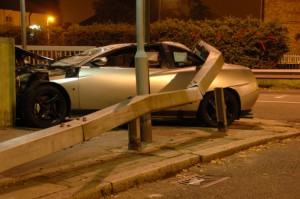Oklahoma City’s Worst Intersections for Drunk and Impaired Driving Accidents

Drunk driving accidents claim far too many lives in Oklahoma. Crashes involving intoxicated and impaired drivers are on the decline nationwide. In 2011 drunk-driving fatalities dropped below 10,000 for the first time, according to Mothers Against Drunk Driving. However, Oklahoma has struggled to reduce alcohol-related traffic crashes. Between 1994 and 2012, drunk driving deaths in Oklahoma increased by 10 percent.
The Oklahoma Highway Safety Office (OHSO) is conducting a public awareness campaign to combat drunk driving on Oklahoma roads. Gary Thomas, Director of OHSO, told Oklahoma Watch that in terms of drunk driving deaths, “we’re bad…we couldn’t get much worse.”
There were a total of 24 alcohol-related auto crash fatalities in Oklahoma County in 2012. The majority of the fatal wrecks took place on the city streets and county roads rather than the highways; Oklahoma State Police responded to six fatal alcohol-related car wrecks, while county and city authorities reported 18 for the year.
Oklahoma City’s News 9 analyzed 2012 county traffic crash data to determine some of the most dangerous streets and intersections in Oklahoma City and the surrounding county. The station also prepared a map of Oklahoma County that shows where DUI citations occurred throughout 2012.
The four worst areas in Oklahoma County for DUI crashes are listed below:
- May Ave. and SW 29th. Four impaired driving wrecks that injured a total of five people took place within a nine-block area of this intersection.
- May Ave. and SW 51st, which was the location of drunk driving accidents that injured seven people.
- Pennsylvania Ave. near Hefner and Britton was a particularly bad spot for impaired driving wrecks; there were four such accidents in that area in 2012.
- Douglas Blvd. in Midwest City north of I-40. There were 10 drunk driving collisions on this road, including four at the intersection of Douglas and SE 29th.
Although Oklahoma drivers are advised to avoid areas where drunk driving is a common problem, many of the places on the list of worst intersections are high traffic areas.
Oklahoma highway safety leaders have outlined goals to reduce impaired driving deaths throughout Oklahoma. In 2014, the Highway Safety Office hopes to reduce the number of fatal crashes involving drunk or drugged drivers to 712 deaths. Next year, the agency is aiming for a further reduction to 697 deaths, and by 2016 OHSO would like that number to drop to 678 impaired driving deaths at most.
Drunk and impaired drivers in Oklahoma’s cities are a significant part of the statewide problem. In 2012, there were 142 alcohol-related auto crashes in Norman, 521 in Tulsa, and 736 in Oklahoma City. Twenty-five people died on Oklahoma City roads and highways in alcohol-related traffic collisions.
Despite all the difficulty authorities are having with harm reduction and prevention, Oklahoma leaders are serious about reducing injuries and fatalities caused by drunk, drugged, or otherwise impaired vehicle operators. A fatal, head-on drunk driving crash in 2009 that ended the life of 20-year-old Oklahoma State University student Erin Swezey spurred lawmakers to action.
In 2011, the Erin Swezey Act became law, recognizing the young woman who was killed by a reckless drunk driver. The law requires DUI offenders to have ignition interlock devices installed on their vehicles so that they cannot drink and drive. First-time offenders with a BAC of 0.08 or more are required to use an ignition interlock for four years, and repeat offenders must use onboard breath tests for five years. DUI offenders are also required to have the words “Interlock Required” printed on their Oklahoma driver licenses.
It’s important to take the right steps after a car accident. If you or a loved one has been harmed by a drunk driver, you should understand your legal options. With our help you can win your case and obtain compensation for your pain, suffering, loss, and other damages.
Blog CATEGORIES
Let's Talk About It
Speak with an experienced attorney at no cost to you

